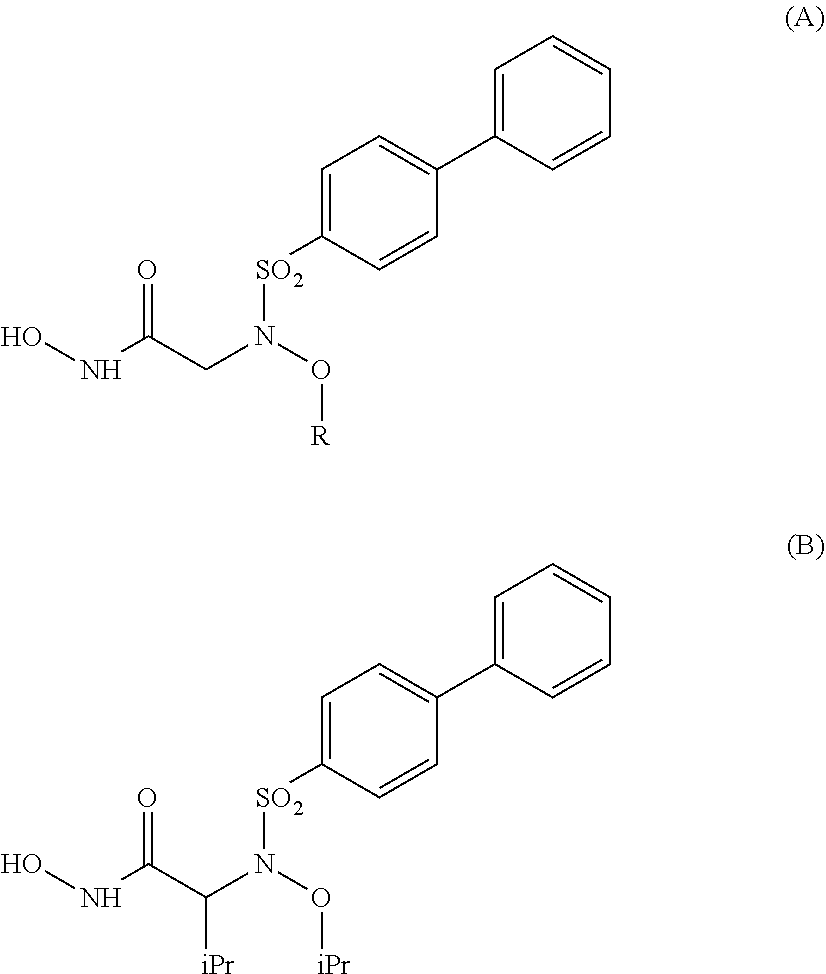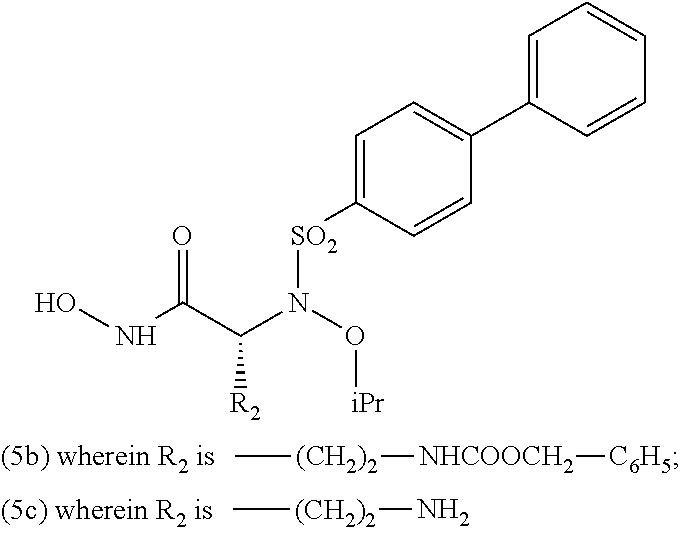Diagnostic Agents Selective Against Metalloproteases
a technology of metalloproteases and diagnostic agents, applied in the field of diagnostics, can solve the problems of abnormal evolution and/or development of tissues, cellular proliferation and invasion, and occurrence of degenerative processes, and achieve the effect of optimal diagnostic visualization and high affinity for specific metalloproteases
- Summary
- Abstract
- Description
- Claims
- Application Information
AI Technical Summary
Benefits of technology
Problems solved by technology
Method used
Image
Examples
example 2
Preparation of compound (1b): (R)—N-(4-(hydroxyamino)-3-(N-isopropoxybiphenyl-4-ylsulfonamido)-4-oxobutyl)benzamide
Preparation of Compound (8)
[0386]N-isopropoxy-1,1′-biphenyl-4-sulfonamide was prepared as previously described by Rossello, A. et al. (Bioorg. Med. Chem. 2004, 12, 2441).
Preparation of Compound (12)
[0387]Tert-butyl ester (12) was prepared from sulfonamide derivative (8) (1.08 g, 3.72 mmol) and alcohol (6) (0.76 g, 2.48 mmol) following the procedure previously described for the preparation of compound (11), as set forth in Example 1. The crude reaction mixture was purified by flash chromatography (n-hexane / AcOEt=5:1), to give (12) (1.14 g, 79% yield) as a yellow oil.
[0388][α]20D=+55° (c=9.1 mg / L, CHCl3);
[0389]1H-NMR (CDCl3) δ: 1.22-1.25 (m, 15H); 2.04 (m, 2H); 3.22-3.37 (m, 2H); 4.12 (dd, J=7.14 Hz, J=14.29 Hz, 1H); 4.43 (septet, J=6.2 Hz, 1H); 5.08 (s, 2H); 7.34 (m, 5H); 7.42-7.53 (m, 3H); 7.55-7.61 (m, 2H); 7.7-7.74 (m, 2H); 7.94-7.98 (m, 2H).
Preparation of Compound (1...
example 3
Preparation of compound (1c): (R)—N-hydroxy-2-(N-isopropoxybiphenyl-4-ylsulfonamido)-4-(methylsulfonamido)butanamide
Preparation of Compound (18)
[0401]A solution of compound (15) prepared according to Example 2 (0.30 g, 0.60 mmol), in dry THF (3 mL), was treated with methanesulfonyl chloride (0.05 mL, 0.60 mmol) and N-methylmorpholine (0.13 mL, 1.2 mmol). The reaction mixture was stirred at room temperature overnight, then was diluted with AcOEt, washed with H2O, dried over Na2SO4 and evaporated. The crude was purified by flash chromatography (n-hexane / AcOEt=3:2), to give (18) (100 mg, 32% yield) as a yellow oil.
[0402]1H-NMR (CDCl3) δ: 1.14 (brs, 9H); 1.20-1.26 (m, 6H); 2.04 (brs, 2H); 2.95 (s, 3H); 3.29 (brs, 2H); 4.25 (t, J=7.1 Hz, 1H); 4.42 (septet, 1H); 7.43-7.54 (m, 3H); 7.58-7.62 (m, 2H); 7.74-7.78 (m, 2H); 7.96-8.00 (m, 2H).
Preparation of Compound (24)
[0403]Following a procedure analogous to that used for the preparation of compound (35), in Example 1, ester derivative (18) (1...
example 4
Preparation of compound (1d): (R)-4-acetamido-N-hydroxy-2-(N-isopropoxybiphenyl-4-ylsulfonamido)butanamide
Preparation of Compound (19)
[0409]Following a procedure analogous to that used for the preparation of compound (17), in Example 2, ester derivative (15) (0.30 g, 0.59 mmol) was acylated with acetyl chloride. Silica gel column chromatography (n-hexane / AcOEt=1:1) yielded the desired product (19) (60 mg, 22% yield).
[0410]1H-NMR (CDCl3) δ: 1.19-1.24 (m, 15H); 1.90-2.01 (m, 5H); 3.13-3.23 (m, 1H); 3.53 (m, 1H); 4.12 (m, 1H); 4.40 (septet, 1H); 6.11 (brs, 1H); 7.41-7.52 (m, 3H); 7.57-7.61 (m, 2H); 7.72-7.76 (m, 2H); 7.94-7.98 (m, 2H).
[0411]13C-NMR (CDCl3) δ: 21.17; 23.48; 27.76; 36.17; 63.59; 79.80; 82.25; 127.39; 127.52; 128.72; 129.16; 130.14; 133.80; 139.19; 146.84; 170.22.
Preparation of Compound (25)
[0412]Following a procedure analogous to that used for the preparation of compound (35), in Example 1, ester derivative (19) (60 mg, 0.12 mmol) was treated with TFA to give the desired...
PUM
| Property | Measurement | Unit |
|---|---|---|
| optically active | aaaaa | aaaaa |
| fluorescent | aaaaa | aaaaa |
| MRI | aaaaa | aaaaa |
Abstract
Description
Claims
Application Information
 Login to View More
Login to View More - R&D
- Intellectual Property
- Life Sciences
- Materials
- Tech Scout
- Unparalleled Data Quality
- Higher Quality Content
- 60% Fewer Hallucinations
Browse by: Latest US Patents, China's latest patents, Technical Efficacy Thesaurus, Application Domain, Technology Topic, Popular Technical Reports.
© 2025 PatSnap. All rights reserved.Legal|Privacy policy|Modern Slavery Act Transparency Statement|Sitemap|About US| Contact US: help@patsnap.com



